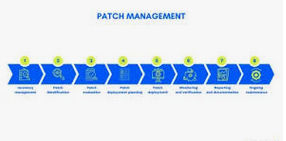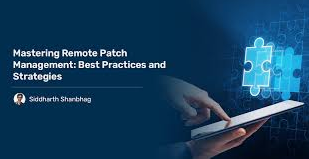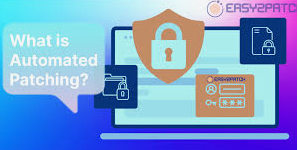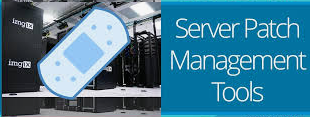I. Introduction
In today’s rapidly evolving digital landscape, maintaining the security and efficiency of IT systems is paramount. One of the most critical aspects of this maintenance is RMM patch management. This comprehensive guide will delve into the intricacies of RMM patch management, exploring its significance, implementation, and best practices.
RMM patch management refers to the process of using Remote Monitoring and Management (RMM) tools to efficiently distribute and apply software updates, known as patches, across multiple systems and devices. These patches are crucial for addressing security vulnerabilities, fixing bugs, and improving overall system performance.
The importance of patch management in IT security cannot be overstated. According to a report by the Ponemon Institute, 57% of data breaches are attributed to poor patch management practices. By implementing a robust RMM patch management strategy, organizations can significantly reduce their risk of falling victim to cyber attacks that exploit known vulnerabilities.
RMM tools serve as the backbone of efficient patch management. These solutions provide IT administrators with a centralized platform to monitor, manage, and maintain numerous devices and systems across an organization’s network. By leveraging RMM capabilities, businesses can streamline their patch management processes, ensuring that all systems remain up-to-date and secure.
II. Understanding RMM Patch Management
What is RMM?
Remote Monitoring and Management (RMM) is a set of tools and technologies that enable IT professionals to oversee and control IT systems from a distance. RMM solutions provide a comprehensive suite of features, including:
- Real-time monitoring of system health and performance
- Remote access for troubleshooting and maintenance
- Automated alerts and notifications
- Asset tracking and inventory management
- Patch management and software distribution
These capabilities allow IT teams to proactively manage and maintain their infrastructure, reducing downtime and improving overall efficiency.
How does patch management fit into RMM?
Patch management is a critical component of RMM solutions. By integrating patch management into the RMM framework, organizations can automate and streamline the process of identifying, testing, and deploying patches across their entire IT environment. This integration offers several key advantages:
- Centralized control: IT administrators can manage patches for all systems from a single console, eliminating the need for manual, device-by-device updates.
- Automated patch discovery: RMM tools can automatically scan for available patches and updates, ensuring that no critical fixes are missed.
- Scheduling and prioritization: Patches can be scheduled for deployment during off-hours to minimize disruption, and critical updates can be prioritized based on severity.
- Reporting and compliance: Detailed reports on patch status and compliance can be generated, helping organizations meet regulatory requirements and internal security policies.
Benefits of using RMM for patch management
Implementing RMM patch management offers numerous benefits for organizations of all sizes:
| Benefit | Description |
|---|---|
| Enhanced security | Timely application of security patches reduces the risk of exploitation by cybercriminals. |
| Improved efficiency | Automation reduces the time and effort required for manual patch management. |
| Reduced downtime | Proactive patching helps prevent system failures and performance issues. |
| Cost savings | Centralized management and automation lead to reduced IT labor costs. |
| Scalability | RMM solutions can easily scale to accommodate growing IT environments. |
By leveraging RMM for patch management, organizations can significantly improve their security posture while streamlining IT operations. As we delve deeper into the intricacies of RMM patch management in the following sections, we’ll explore the process, best practices, and challenges associated with this critical IT function.
III. The Patch Management Process
Effective RMM patch management follows a structured process to ensure that systems are updated efficiently and securely. Let’s break down this process into its key components:
A. Identifying vulnerabilities and available patches
The first step in the patch management process is to identify vulnerabilities in your systems and the patches available to address them. RMM tools facilitate this by:
- Continuously scanning systems for outdated software and known vulnerabilities
- Maintaining an up-to-date database of available patches from various software vendors
- Providing alerts and notifications when new patches are released or vulnerabilities are discovered
This proactive approach ensures that IT teams are always aware of potential security risks and have the necessary information to address them promptly.
B. Testing patches in a controlled environment
Before deploying patches across your entire network, it’s crucial to test them in a controlled environment. This step helps identify any potential conflicts or issues that could arise from the patch installation. The testing process typically involves:
- Setting up a test environment that mirrors your production systems
- Applying patches to a small subset of devices or virtual machines
- Monitoring these systems for any adverse effects or performance issues
- Conducting user acceptance testing to ensure critical applications remain functional
By thoroughly testing patches, organizations can minimize the risk of disruptions to their production environment.
C. Deploying patches across multiple systems
Once patches have been tested and approved, the next step is to deploy them across your network. RMM patch management solutions excel in this area by providing:
- Automated deployment schedules to minimize business disruption
- The ability to group devices and stagger patch rollouts
- Options for forced reboots or user-initiated installations
- Rollback capabilities in case of unexpected issues
This level of control and automation ensures that patches are deployed efficiently and with minimal impact on end-users.
D. Monitoring and reporting on patch status
The final step in the RMM patch management process is ongoing monitoring and reporting. This involves:
- Tracking the progress of patch deployments across all systems
- Identifying any failed installations or systems that require manual intervention
- Generating reports on patch compliance and overall system security status
- Providing dashboards for real-time visibility into the patch management process
These monitoring and reporting capabilities allow IT teams to maintain a clear overview of their network’s security posture and quickly address any issues that arise.
IV. Key Features of RMM Patch Management Solutions
To effectively implement RMM patch management, it’s important to understand the key features that make these solutions powerful and efficient. Here are the essential capabilities to look for:
A. Automated patch discovery and deployment
Automation is at the heart of effective RMM patch management. Look for solutions that offer:
- Automatic scanning and detection of missing patches
- Scheduled patch downloads and installations
- The ability to set rules and policies for automated deployment
- Support for various operating systems and third-party applications
For example, a robust RMM solution might allow you to set a policy that automatically deploys critical security patches to all Windows servers within 24 hours of release, after a successful test deployment.
B. Centralized management console
A centralized management console is crucial for overseeing patch management across large and diverse IT environments. Key features include:
- A unified dashboard for monitoring all systems and devices
- The ability to group devices by type, department, or location
- Customizable views and reports
- Role-based access control for different team members
This centralized approach allows IT administrators to efficiently manage patches across the entire organization from a single interface.
C. Scheduling and prioritization of patches
Flexible scheduling and prioritization capabilities are essential for minimizing disruptions to business operations. Look for features such as:
- The ability to schedule patches during off-hours or maintenance windows
- Options to prioritize patches based on severity or business impact
- Support for creating multiple deployment schedules for different device groups
- The ability to postpone or skip certain updates if necessary
These features allow organizations to balance security needs with operational requirements, ensuring that critical systems remain available when needed.
D. Reporting and compliance tracking
Comprehensive reporting is crucial for maintaining visibility into your patch management efforts and demonstrating compliance with security standards. Key reporting features include:
- Detailed patch status reports for individual devices and the entire network
- Compliance reports for various regulatory standards (e.g., HIPAA, PCI DSS)
- Historical data on patch deployments and system vulnerabilities
- Customizable report templates and scheduling options
These reporting capabilities not only help IT teams stay on top of their patch management efforts but also provide valuable documentation for audits and compliance reviews.
| Feature | Benefit |
|---|---|
| Automated discovery and deployment | Reduces manual effort and ensures timely patching |
| Centralized management console | Improves oversight and control across diverse IT environments |
| Flexible scheduling and prioritization | Minimizes business disruptions while addressing critical vulnerabilities |
| Comprehensive reporting | Enhances visibility, aids in decision-making, and supports compliance efforts |
By leveraging these key features, organizations can implement a robust RMM patch management strategy that enhances security, improves efficiency, and maintains compliance with industry standards.
V. Best Practices for RMM Patch Management
Implementing an effective RMM patch management strategy requires adherence to best practices. These guidelines ensure that your patch management process is both efficient and secure:
A. Establishing a patch management policy
A comprehensive patch management policy is the foundation of a successful RMM patch management strategy. This policy should include:
- Clearly defined roles and responsibilities for patch management
- Timeframes for applying different types of patches (e.g., critical security updates vs. feature updates)
- Procedures for testing and approving patches
- Guidelines for handling emergency patches
- Documentation requirements for patch-related activities
By establishing and enforcing a formal policy, organizations can ensure consistency in their patch management efforts and minimize security risks.
B. Regular patch assessment and prioritization
Not all patches are created equal. It’s crucial to regularly assess available patches and prioritize them based on factors such as:
- Severity of the vulnerability being addressed
- Potential impact on business operations
- Likelihood of exploitation
- Applicability to your specific IT environment
Consider using a risk assessment matrix to help prioritize patches:
| Severity | Likelihood of Exploitation | Priority |
|---|---|---|
| High | High | Critical – Deploy immediately |
| High | Low | High – Deploy within 48 hours |
| Low | High | Medium – Deploy within 1 week |
| Low | Low | Low – Deploy during next maintenance window |
C. Testing patches before deployment
Thorough testing is crucial to prevent patches from causing unintended consequences in your production environment. Best practices for patch testing include:
- Maintaining a test environment that closely mirrors your production systems
- Using virtualization to quickly create and dispose of test environments
- Testing patches on a representative sample of device types and configurations
- Involving end-users in the testing process for critical business applications
- Documenting test results and any issues encountered
Remember, the goal of testing is not just to verify that patches install correctly, but also to ensure they don’t negatively impact system performance or application functionality.
D. Managing patch deployments across different device types
Modern IT environments often include a diverse range of devices, from servers and workstations to mobile devices and IoT sensors. Effective RMM patch management requires strategies for handling this diversity:
- Group devices by type, operating system, or function for targeted patch deployment
- Use different deployment schedules for various device groups (e.g., servers vs. workstations)
- Implement mobile device management (MDM) solutions for patching mobile devices
- Consider using specialized patch management tools for unique or legacy systems
By tailoring your approach to different device types, you can ensure comprehensive coverage while minimizing disruptions.
E. Handling failed patch installations
Despite best efforts, patch installations sometimes fail. A robust RMM patch management strategy should include procedures for handling these situations:
- Set up automated alerts for failed patch installations
- Establish a process for investigating and documenting the cause of failures
- Develop troubleshooting guides for common patch installation issues
- Implement a system for tracking and resolving failed installations
- Consider creating a dedicated team or role for handling complex patching issues
By proactively addressing failed installations, you can maintain the security and stability of your IT environment.
VI. Common Challenges in RMM Patch Management
While RMM patch management offers numerous benefits, it also comes with its share of challenges. Understanding these challenges is crucial for developing effective strategies to overcome them:
A. Dealing with legacy systems
Many organizations still rely on legacy systems that may not be supported by modern patch management tools. Challenges include:
- Limited or no vendor support for outdated operating systems
- Incompatibility with modern security patches
- Risk of system instability when applying patches to legacy software
Solution: Consider isolating legacy systems on separate networks, implementing compensating controls, or exploring virtualization solutions to extend the life of legacy applications while maintaining security.
B. Managing patches for remote and mobile devices
With the rise of remote work and mobile computing, ensuring all devices are properly patched has become increasingly challenging:
- Devices may not be consistently connected to the corporate network
- Bandwidth limitations can impede patch downloads
- Users may delay or avoid applying patches on personal devices used for work
Solution: Implement a robust mobile device management (MDM) solution, use cloud-based patch management tools, and educate users on the importance of timely updates.
C. Balancing security needs with business continuity
Applying patches often requires system reboots or downtime, which can conflict with business operations:
- Critical systems may have limited maintenance windows
- Patches may introduce compatibility issues with business-critical applications
- Frequent patching can lead to patch fatigue among IT staff and users
Solution: Implement a risk-based approach to prioritize patches, use maintenance windows effectively, and consider solutions that allow for live patching of certain systems.
D. Keeping up with the volume of patches
The sheer number of patches released across various software and systems can be overwhelming:
- Multiple vendors releasing patches on different schedules
- Patches for operating systems, applications, and firmware to manage
- Emergency out-of-band patches disrupting planned schedules
Solution: Leverage automation tools to streamline patch discovery and deployment, prioritize patches based on risk, and consider consolidating software vendors to reduce complexity.
By acknowledging these challenges and implementing targeted solutions, organizations can significantly improve their RMM patch management processes and maintain a more secure IT environment.
VII. Choosing the Right RMM Patch Management Solution
Selecting the appropriate RMM patch management solution is crucial for the success of your patching strategy. Here are key factors to consider and a comparison of popular tools:
A. Key factors to consider
- Compatibility: Ensure the solution supports your operating systems and applications.
- Scalability: The tool should be able to grow with your organization.
- Automation capabilities: Look for robust automation features to reduce manual work.
- Reporting and analytics: Comprehensive reporting helps track patch status and compliance.
- Integration: Consider how well the solution integrates with your existing IT infrastructure.
- Cost: Evaluate the total cost of ownership, including licensing, implementation, and ongoing support.
B. Popular RMM patch management tools comparison
| Tool | Key Features | Best For |
|---|---|---|
| N-able N-central | Comprehensive RMM solution, strong automation | MSPs and large enterprises |
| ConnectWise Automate | Extensive scripting capabilities, wide integration options | IT service providers and mid-size businesses |
| Kaseya VSA | Advanced reporting, multi-tenant architecture | MSPs and organizations with complex environments |
| NinjaRMM | User-friendly interface, cloud-based solution | Small to medium-sized businesses |
C. Integration with existing IT infrastructure
When selecting an RMM patch management solution, consider how it will integrate with your existing tools and processes:
- Asset management systems
- Service desk and ticketing platforms
- Security information and event management (SIEM) tools
- Backup and disaster recovery solutions
Seamless integration can significantly enhance the efficiency of your overall IT operations.
VIII. Implementing RMM Patch Management
A successful implementation of RMM patch management requires careful planning and execution. Follow these steps to ensure a smooth rollout:
A. Planning and preparation
- Assess your current patch management processes and identify areas for improvement.
- Define clear objectives for your RMM patch management implementation.
- Create a project team with representatives from IT, security, and business units.
- Develop a detailed implementation plan, including timelines and milestones.
- Conduct a thorough inventory of all systems and applications in your environment.
B. Initial setup and configuration
Once you’ve selected your RMM patch management solution, follow these steps for initial setup:
- Install and configure the RMM software on a test environment.
- Set up device groups and policies based on your organization’s structure.
- Configure patch approval workflows and deployment schedules.
- Integrate the RMM solution with your existing tools and systems.
- Conduct thorough testing of all configured features and workflows.
C. Training IT staff on the new system
Proper training is essential for the successful adoption of your new RMM patch management solution:
- Provide comprehensive training sessions for all IT staff involved in patch management.
- Create documentation and quick reference guides for common tasks.
- Consider certification programs offered by the RMM vendor.
- Implement a mentoring system where experienced users can support newcomers.
- Schedule regular refresher training to cover new features and best practices.
D. Establishing ongoing maintenance procedures
To ensure the long-term success of your RMM patch management implementation, establish these ongoing maintenance procedures:
- Regularly review and update patch management policies and procedures.
- Conduct periodic audits of patch compliance across your environment.
- Stay informed about new features and updates for your RMM solution.
- Continuously optimize patch deployment schedules and automation rules.
- Regularly backup your RMM configuration and data.
IX. Measuring the Success of Your RMM Patch Management Strategy
To ensure your RMM patch management strategy is effective, it’s crucial to measure its success using key performance indicators (KPIs) and ongoing analysis.
A. Key performance indicators (KPIs) to track
- Patch compliance rate: Percentage of systems that are up-to-date with required patches.
- Mean time to patch: Average time between patch release and successful deployment.
- Patch failure rate: Percentage of patch installations that fail or cause issues.
- Patch-related incidents: Number of security incidents or outages caused by missing patches.
- Automation rate: Percentage of patch-related tasks that are automated.
B. Analyzing patch compliance rates
Regularly analyze your patch compliance rates to identify trends and areas for improvement:
- Track compliance rates by device type, operating system, and department.
- Investigate the root causes of persistent non-compliance.
- Set target compliance rates and track progress towards these goals.
- Use compliance data to inform resource allocation and process improvements.
C. Assessing impact on security incidents
Evaluate how your RMM patch management strategy impacts your overall security posture:
- Track the number of security incidents related to known vulnerabilities.
- Analyze the severity and impact of security incidents before and after implementation.
- Calculate the potential cost savings from prevented security breaches.
- Use security incident data to refine patch prioritization and deployment strategies.
D. Continual improvement of the patch management process
Use the insights gained from your KPIs and analysis to continually improve your patch management process:
- Regularly review and update your patch management policy and procedures.
- Solicit feedback from IT staff and end-users on the patching process.
- Stay informed about industry best practices and emerging technologies.
- Conduct periodic audits of your patch management process.
- Invest in ongoing training and skill development for your IT team.
X. Future Trends in RMM Patch Management
As technology evolves, so does the landscape of RMM patch management. Stay ahead of the curve by keeping an eye on these emerging trends:
A. AI and machine learning in patch prioritization
Artificial Intelligence (AI) and Machine Learning (ML) are set to revolutionize patch management by:
- Analyzing vast amounts of data to predict which patches are most critical.
- Automatically adjusting patch deployment schedules based on system behavior.
- Identifying patterns in patch failures to prevent future issues.
- Providing intelligent recommendations for patch testing and deployment strategies.
B. Integration with threat intelligence platforms
Expect tighter integration between RMM patch management tools and threat intelligence platforms, offering benefits such as:
- Real-time vulnerability assessments based on current threat landscapes.
- Automated patch prioritization based on active exploitation attempts.
- Enhanced reporting on security posture and risk exposure.
- Proactive patching strategies informed by predictive threat analysis.
C. Expansion to cover cloud-based assets
As organizations increasingly rely on cloud services, RMM patch management will evolve to include:
- Native integration with major cloud platforms (AWS, Azure, Google Cloud).
- Unified patch management across on-premises and cloud environments.
- Automated patching for containerized applications and microservices.
- Enhanced security for multi-cloud and hybrid cloud architectures.
D. Increased automation in patch deployment
The future of RMM patch management will see even greater levels of automation, including:
- Self-healing systems that can apply patches without human intervention.
- Intelligent scheduling that minimizes business disruption.
- Automated rollback procedures in case of patch-related issues.
- Integration with DevOps pipelines for seamless patching in CI/CD environments.
XI. Conclusion
Effective RMM patch management is a critical component of any organization’s IT security strategy. By implementing a robust patch management process, leveraging the right tools, and staying informed about emerging trends, businesses can significantly enhance their security posture and operational efficiency.
Key takeaways for implementing an effective RMM patch management strategy include:
- Establish a comprehensive patch management policy and stick to it.
- Choose the right RMM solution that fits your organization’s needs and integrates well with your existing infrastructure.
- Prioritize patches based on risk and business impact.
- Regularly test patches before deployment to production environments.
- Monitor and measure the success of your patch management efforts using relevant KPIs.
- Stay informed about emerging trends and continuously improve your processes.
As cyber threats continue to evolve, the importance of timely and effective patch management cannot be overstated. By prioritizing RMM patch management in your overall IT security efforts, you can significantly reduce your organization’s risk exposure and ensure the stability and efficiency of your IT infrastructure.




